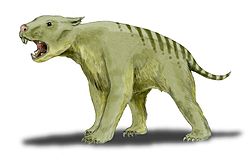| Madakoala | |
|---|---|
| Scientific classification | |
| Domain: | Eukaryota |
| Kingdom: | Animalia |
| Phylum: | Chordata |
| Class: | Mammalia |
| Infraclass: | Marsupialia |
| Order: | Diprotodontia |
| Family: | Phascolarctidae |
| Genus: | † Madakoala Woodburne, Tedford, Archer, and Pledge, 1987 |
| Species | |
Madakoala is a genus of extinct phascolarctid marsupials with three known species, Madakoala devisi,Madakoala wellsiandMadakoala robustus. It is allied to extinct genera Invictokoala, Koobor, Litokoala, Nimiokoala, Perikoala, Phascolarctos and Priscakoala , along with Phascolarctos , the genus of the existing koala. Madakoala went extinct around 280,000 years ago in the Pleistocene epoch. [1] They are known to exist by limited cranial material in fossils, so the existence of some of the subspecies is questionable because of missing dental data. [2]

